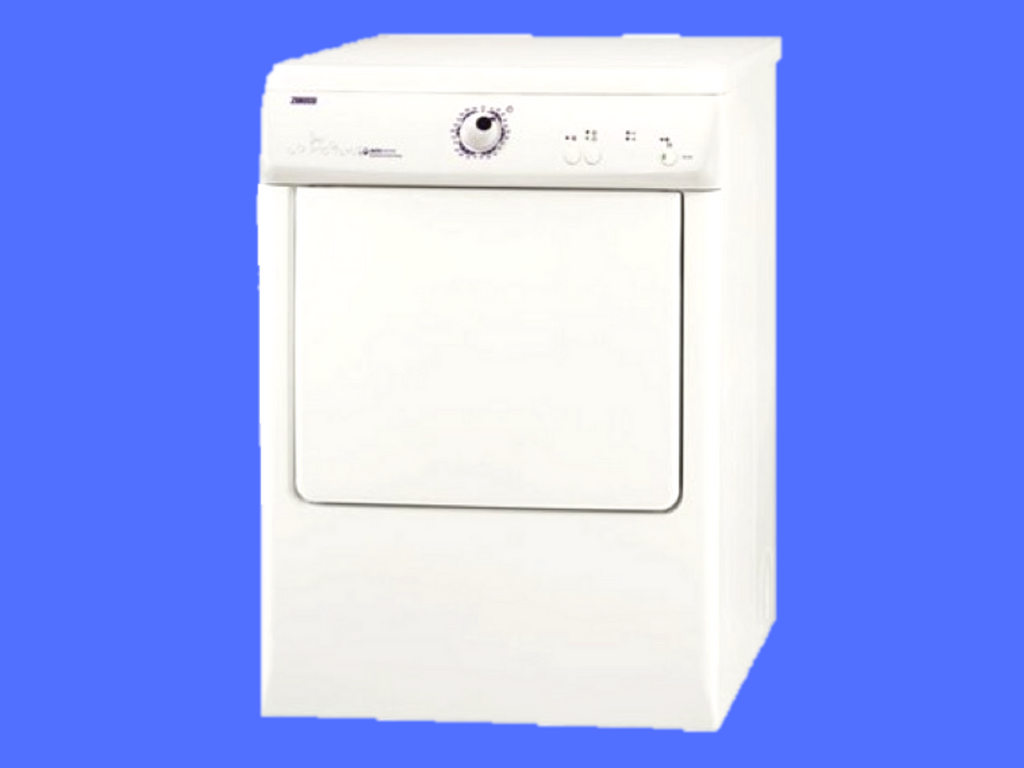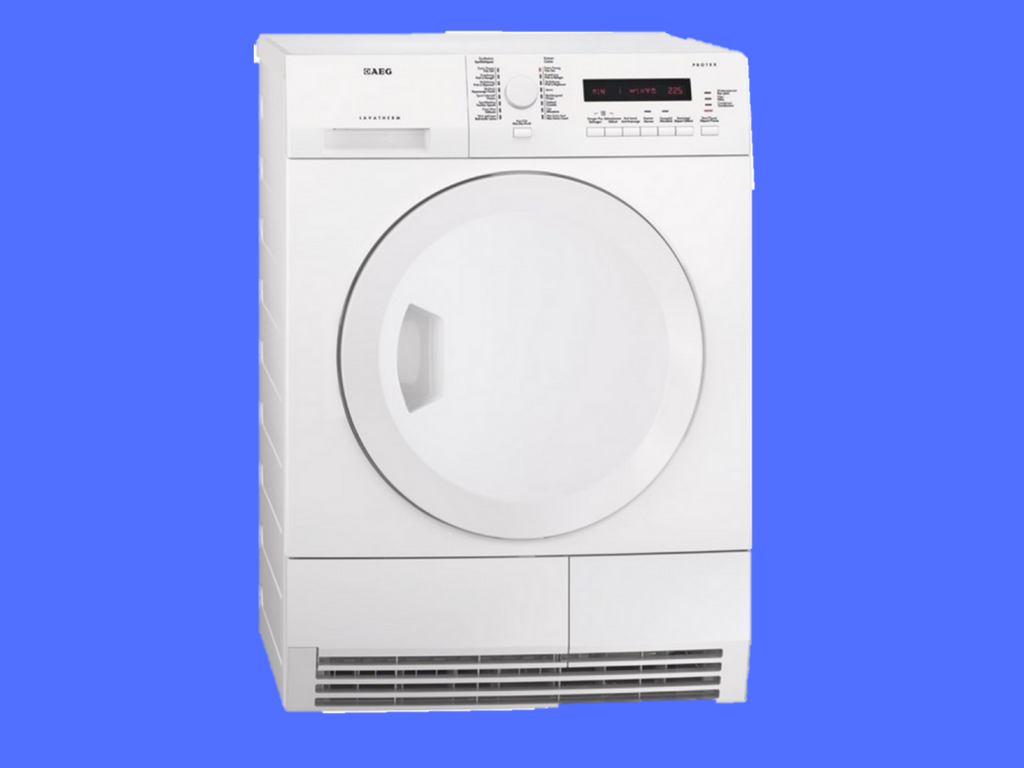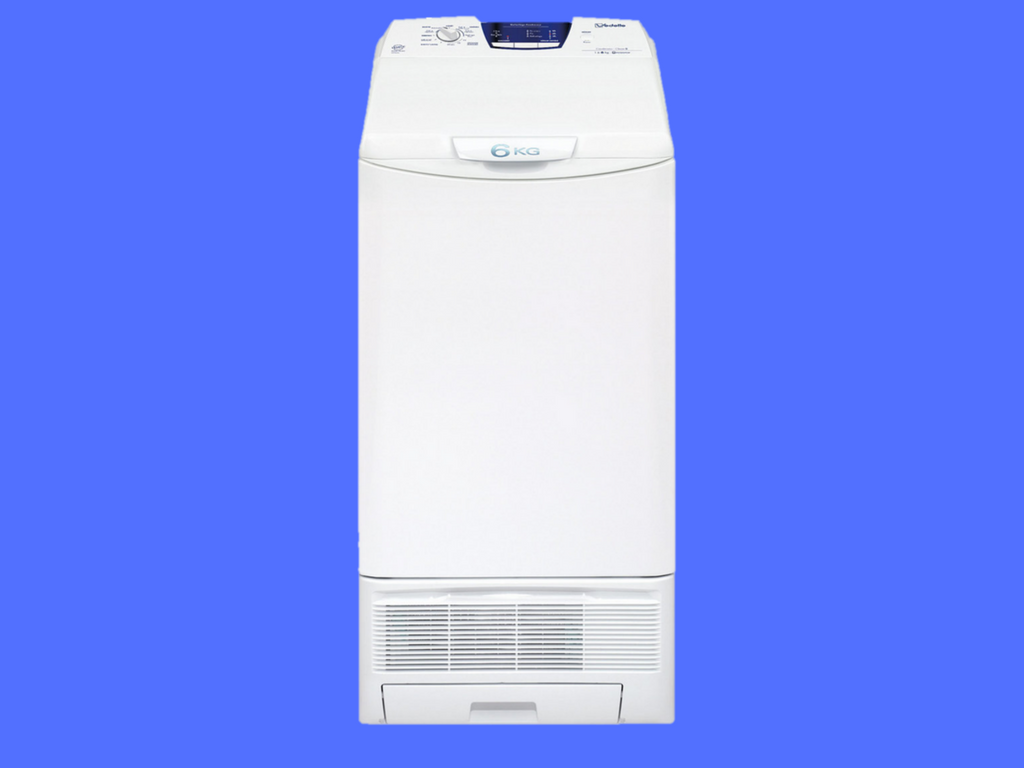This Zabilo expert guide will help you pick out the best tumble dryer for you.
How to choose a tumble dryer during your Online Shopping ?
Most full-sized tumble dryers are about the same size and usually dry a similar weight or load to their corresponding washing machines, around 6kg dry weight of cottons or 2.5kg synthetics.
If you're short of floor space, you may be able to stack your tumble dryer on top of your washing machine, or use it in a spare room or garage.
If the machine is to go under a worktop or into a confined space, please ensure you measure up available space before ordering and don't forget to measure areas of access too.
Condenser or vented dryer? Automatic or manual? 6 or 8kg drum? This expert guide will help you pick out the best tumble dryer for you.
Read more: http://www.which.co.uk/reviews/tumble-dryers/article/how-to-buy-the-best-tumble-dryer - Which?

The tumble drying process
Tumble dryers have larger drums than washing machines, because the larger the drum, the better the efficiency of hot air flow through the machine resulting in faster drying times. Allowing fabrics plenty of room to tumble also means less creasing.
They also have a timer or sensor to control the length of the drying cycle. During the last ten minutes or so of the cycle, the heating element is turned off and the fabrics tumble in cooling air back to ambient room temperature. This reduces the effect of static and 'fibre shock', which causes creasing.

Some machines have a cool air setting which can be used to air fabrics stored away for some time. Most full-size machines have a reverse tumble feature which means that the drum rotates both ways, pausing in between. This keeps laundry separated and dries it more evenly and quickly.
Some machines even have a crease care feature; they'll continue to give fabrics an intermittent tumble for half an hour or more at the end of the cycle so they don't get creased in the drum if you can't empty the machine straight away.Your tumble dryer will also have a filter, often on the inside of the door, which collects stray fibres and needs to be cleaned out regularly to ensure best drying performance.
Which type is the best for you?
Pros:
-
If your laundry room is tight on space, this tumble dryer can be stacked.
-
Its large capacity allows you to wash more items at once and accomodates bulky items, without sacrificing cleaning performance.
Cons: It may vibrate quite a bit on the spin cycle, especially if it's not installed on a reinforced floor.

Top loading tumble dryer :
Pros:
-
You don't have to bend as much when you're putting clothes in and taking them out.Minimal vibration.
-
You're unlikely to have musty odors to deal with.
-
You'll find its control panel uncomplicated and intuitive-to-operate.
Cons:It's not stackable.

Vented or condenser ?
You will need to choose between a vented or condenser tumble dryer.
-
A vented machine takes the damp air produced by the drying process and discharges it outside the home using a 2m plastic hose (sometimes supplied) to prevent condensation. A permanent vent can be fitted in an outside wall or you can simply hang the hose out of an open window.
-
A condenser dryer where the machine separates water from the moist air into a container which is emptied after drying, or sometimes pumped out via the washing machine plumbing if appropriate. You can install a condenser dryer in any well-ventilated room, and though the majority are a little more expensive to run you may prefer the freedom of not having to use a hose.
What about the capacity ?
Drying capacity can be measured in the same way as wash capacity, with every kilogram being equal to roughly one outfit including a pair of trousers, top, underwear and socks.
The larger the capacity, the more drying you can do. Larger drums improve hot air flow, decreasing drying times and helping energy efficiency. The additional space also reduces creasing in your clothes, and smooth stainless steel drums prevent fabrics from catching. Ranging from compact 3 kg models to big 9 kg machine capacities, we have a tumble dryer to suit households of all sizes.
Energy efficiency and the environment
All machines receive an energy and drying performance grading A -G, A being the most economical. Standardised tests, monitored by Trading Standards, are carried out across the industry and manufacturers are responsible for grading their own appliances. Running costs will depend on how much time the machine is drying for and how hard it has to work.
A way of helping to keep costs down is by by ensuring that you don't overload the machine, dry similar fabrics together, and spin dry your washload at the highest spin speed as possible before loading the dryer.
Some machines will have a timer delay so you can use the machine overnight on a cheaper electricity tariff. Others have sensors which tell them when the washing is dry and then shut off the heater, saving energy and preventing over-drying; you'll pay a bit more but will save on running costs.
Buy right now the best Tumble Dryer for Great Price at Zabilo, your Israeli Online Shopping in English !
Tumble dryer capacities: large, average or compact? Tumble dryers come with different capacities, ranging from compact models that can dry 3kg of laundry all the way up to very large, 9kg-capacity models. Below we explain the pros and cons of the different sizes. Large drum size - capacity of 8kg or more Using a large-capacity tumble dryer can make for a low energy-efficient way of drying your laundry, as long as you're able to fill the drum to the program's capacity every time. Per kilo of laundry, bigger machines will take less time to dry clothes than smaller or compact dryers. But buy a dryer you struggle to fill and you'll risk using more energy than you need. The largest dryers have capacities of 8kg or more and tend to be most suitable for families and large households that have stack of washing to dry. The biggest tumble dryer we’ve tested is a Bosch with a massive 10kg capacity, meaning it could dry almost two washing-machine loads at once. That tumble dryer has now been discontinued, but we've also reviewed and rated several 9kg-capacity tumble dryers. Average drum size - 6-7kg capacity The most common drum sizes are 6kg and 7kg-capacity tumble dryers. We fill dryers to 70% of their maximum capacity to simulate how they are used at home. That means a 6kg drum could dry 17-18 men's cotton shirts at once, and a 7kg model could dry 20-21 shirts. If that sounds about right, these are the right size dryers for you – and with so many competing 6-7kg models on the market, there's plenty to choose from. Compact tumble dryers - 3-5kg capacity Compact tumble dryers have capacities from as small as 3kg. If you live on your own, or space is very tight, and you'd like a tumble dryer, a compact dryer will be able to dry small loads. Unfortunately, compact tumble dryers are slower and less efficient than bigger tumble dryers. Their size also means they aren’t ideal for getting a family's clothes dry quickly.
Read more: http://www.which.co.uk/reviews/tumble-dryers/article/how-to-buy-the-best-tumble-dryer - Which?
Tumble dryer capacities: large, average or compact? Tumble dryers come with different capacities, ranging from compact models that can dry 3kg of laundry all the way up to very large, 9kg-capacity models. Below we explain the pros and cons of the different sizes. Large drum size - capacity of 8kg or more Using a large-capacity tumble dryer can make for a low energy-efficient way of drying your laundry, as long as you're able to fill the drum to the program's capacity every time. Per kilo of laundry, bigger machines will take less time to dry clothes than smaller or compact dryers. But buy a dryer you struggle to fill and you'll risk using more energy than you need. The largest dryers have capacities of 8kg or more and tend to be most suitable for families and large households that have stack of washing to dry. The biggest tumble dryer we’ve tested is a Bosch with a massive 10kg capacity, meaning it could dry almost two washing-machine loads at once. That tumble dryer has now been discontinued, but we've also reviewed and rated several 9kg-capacity tumble dryers. Average drum size - 6-7kg capacity The most common drum sizes are 6kg and 7kg-capacity tumble dryers. We fill dryers to 70% of their maximum capacity to simulate how they are used at home. That means a 6kg drum could dry 17-18 men's cotton shirts at once, and a 7kg model could dry 20-21 shirts. If that sounds about right, these are the right size dryers for you – and with so many competing 6-7kg models on the market, there's plenty to choose from. Compact tumble dryers - 3-5kg capacity Compact tumble dryers have capacities from as small as 3kg. If you live on your own, or space is very tight, and you'd like a tumble dryer, a compact dryer will be able to dry small loads. Unfortunately, compact tumble dryers are slower and less efficient than bigger tumble dryers. Their size also means they aren’t ideal for getting a family's clothes dry quickly.
Read more: http://www.which.co.uk/reviews/tumble-dryers/article/how-to-buy-the-best-tumble-dryer - Which?
Tumble dryer capacities: large, average or compact? Tumble dryers come with different capacities, ranging from compact models that can dry 3kg of laundry all the way up to very large, 9kg-capacity models. Below we explain the pros and cons of the different sizes. Large drum size - capacity of 8kg or more Using a large-capacity tumble dryer can make for a low energy-efficient way of drying your laundry, as long as you're able to fill the drum to the program's capacity every time. Per kilo of laundry, bigger machines will take less time to dry clothes than smaller or compact dryers. But buy a dryer you struggle to fill and you'll risk using more energy than you need. The largest dryers have capacities of 8kg or more and tend to be most suitable for families and large households that have stack of washing to dry. The biggest tumble dryer we’ve tested is a Bosch with a massive 10kg capacity, meaning it could dry almost two washing-machine loads at once. That tumble dryer has now been discontinued, but we've also reviewed and rated several 9kg-capacity tumble dryers. Average drum size - 6-7kg capacity The most common drum sizes are 6kg and 7kg-capacity tumble dryers. We fill dryers to 70% of their maximum capacity to simulate how they are used at home. That means a 6kg drum could dry 17-18 men's cotton shirts at once, and a 7kg model could dry 20-21 shirts. If that sounds about right, these are the right size dryers for you – and with so many competing 6-7kg models on the market, there's plenty to choose from. Compact tumble dryers - 3-5kg capacity Compact tumble dryers have capacities from as small as 3kg. If you live on your own, or space is very tight, and you'd like a tumble dryer, a compact dryer will be able to dry small loads. Unfortunately, compact tumble dryers are slower and less efficient than bigger tumble dryers. Their size also means they aren’t ideal for getting a family's clothes dry quickly.
Read more: http://www.which.co.uk/reviews/tumble-dryers/article/how-to-buy-the-best-tumble-dryer - Which?
Tumble dryer capacities: large, average or compact? Tumble dryers come with different capacities, ranging from compact models that can dry 3kg of laundry all the way up to very large, 9kg-capacity models. Below we explain the pros and cons of the different sizes. Large drum size - capacity of 8kg or more Using a large-capacity tumble dryer can make for a low energy-efficient way of drying your laundry, as long as you're able to fill the drum to the program's capacity every time. Per kilo of laundry, bigger machines will take less time to dry clothes than smaller or compact dryers. But buy a dryer you struggle to fill and you'll risk using more energy than you need. The largest dryers have capacities of 8kg or more and tend to be most suitable for families and large households that have stack of washing to dry. The biggest tumble dryer we’ve tested is a Bosch with a massive 10kg capacity, meaning it could dry almost two washing-machine loads at once. That tumble dryer has now been discontinued, but we've also reviewed and rated several 9kg-capacity tumble dryers. Average drum size - 6-7kg capacity The most common drum sizes are 6kg and 7kg-capacity tumble dryers. We fill dryers to 70% of their maximum capacity to simulate how they are used at home. That means a 6kg drum could dry 17-18 men's cotton shirts at once, and a 7kg model could dry 20-21 shirts. If that sounds about right, these are the right size dryers for you – and with so many competing 6-7kg models on the market, there's plenty to choose from. Compact tumble dryers - 3-5kg capacity Compact tumble dryers have capacities from as small as 3kg. If you live on your own, or space is very tight, and you'd like a tumble dryer, a compact dryer will be able to dry small loads. Unfortunately, compact tumble dryers are slower and less efficient than bigger tumble dryers. Their size also means they aren’t ideal for getting a family's clothes dry quickly.
Read more: http://www.which.co.uk/reviews/tumble-dryers/article/how-to-buy-the-best-tumble-dryer - Which?
Tumble dryer capacities: large, average or compact? Tumble dryers come with different capacities, ranging from compact models that can dry 3kg of laundry all the way up to very large, 9kg-capacity models. Below we explain the pros and cons of the different sizes. Large drum size - capacity of 8kg or more Using a large-capacity tumble dryer can make for a low energy-efficient way of drying your laundry, as long as you're able to fill the drum to the program's capacity every time. Per kilo of laundry, bigger machines will take less time to dry clothes than smaller or compact dryers. But buy a dryer you struggle to fill and you'll risk using more energy than you need. The largest dryers have capacities of 8kg or more and tend to be most suitable for families and large households that have stack of washing to dry. The biggest tumble dryer we’ve tested is a Bosch with a massive 10kg capacity, meaning it could dry almost two washing-machine loads at once. That tumble dryer has now been discontinued, but we've also reviewed and rated several 9kg-capacity tumble dryers. Average drum size - 6-7kg capacity The most common drum sizes are 6kg and 7kg-capacity tumble dryers. We fill dryers to 70% of their maximum capacity to simulate how they are used at home. That means a 6kg drum could dry 17-18 men's cotton shirts at once, and a 7kg model could dry 20-21 shirts. If that sounds about right, these are the right size dryers for you – and with so many competing 6-7kg models on the market, there's plenty to choose from. Compact tumble dryers - 3-5kg capacity Compact tumble dryers have capacities from as small as 3kg. If you live on your own, or space is very tight, and you'd like a tumble dryer, a compact dryer will be able to dry small loads. Unfortunately, compact tumble dryers are slower and less efficient than bigger tumble dryers. Their size also means they aren’t ideal for getting a family's clothes dry quickly.
Read more: http://www.which.co.uk/reviews/tumble-dryers/article/how-to-buy-the-best-tumble-dryer - Which?













.png)
.png)
 (1).png)
_20210307163133.png)

